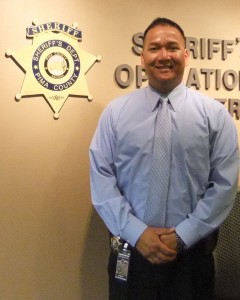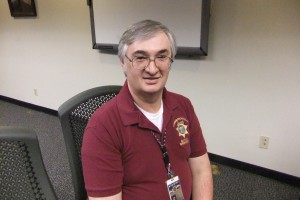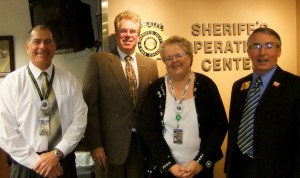They Answered the Call
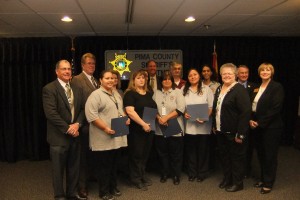
Pima County Sheriff's Department 9-1-1 communications personnel were honored this week by APCO International and representatives of NENA.
On Jan. 8, Tucson, Ariz., and the Pima County Sheriff’s Department were unwillingly thrust onto the world stage when a young man walked up to a political event outside a grocery story and started shooting. This week—National Public Safety Telecommunications Week—APCO International First Vice President Gregg Riddle was in Tucson to recognize the efforts of the 9-1-1 communications center personnel for their professional, competent, compassionate response.
“Public safety communications professionals respond to emergencies that occur in our individual lives and communities, around the clock, 24 hours per day, seven days per week,” said Riddle. “It is unfortunate that sometimes emergencies occur that are so unspeakable that their impact is felt on a much larger scale. This past January, an emergency in Tucson, Ariz., took place that affected us all across this great country. Today, it is my distinct honor and privilege to recognize those here in Pima County who were there to answer the call during this extreme situation.”
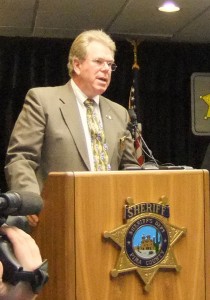
APCO 1st Vice President Gregg Riddle speaks to the press about the contributions of the Pima County Sheriff's Dept. 9-1-1 personnel on Jan. 8.
The first 9-1-1 call to report the shooting that Saturday morning was answered by a dispatcher trainee, Lisa Robinson:
Dispatch: “9-1-1 where is your emergency?”
Caller: “9-1-1, there was a shooting at Safeway, at Ina and, Ina and Oracle, where Gabrielle Giffords was. And I do believe Gabby Giffords was hit.”
Dispatch: “At Safeway sir?”
Caller: “Yeah, Safeway.”
Dispatch: “All right, was somebody shot there sir?”
Caller: “Yes, it looks like the guy had a semi-automatic pistol. He went in, he just started firing, and then he ran.”
Thirty-two calls reporting the incident came in within eight minutes, says 911/Dispatch Manager Pat Joy.
According to the department’s public information officer, Deputy Jason Ogan, the first deputies to arrive—and the first law enforcement officers on scene—responded to the scene at Ina and Oracle within four or five minutes. By that time, bystanders had already tackled the perpetrator, later identified in news reports as 22-year-old Jared Lee Loughner. In all, six people were killed, among them a 9-year-old child and a federal judge, and 13 were wounded, one of whom was Rep. Gabrielle Giffords.
Joy first learned what was happening when Supervisor Tony Portrey called to alert her. “Where can I be of most help?” she asked Portrey when she arrived at the comm center.
At that point, the comm center was staffed at minimum. In addition to Robinson and Portrey, those on duty were dispatchers Carla Miles, Jacqueline Montano, Cecilia Ochoa, Karen Bock and Amanda Rosano, and calltaker Barbara Ward, who was also Robinson’s training officer. The calls were coming in on top of each other, so Joy immediately took a console and started answering the phones.
She says Portrey had isolated the incident on the North Talkgroup (one of four available to dispatchers) and had personnel working the incident in a highly organized fashion.
Capt. Paul Wilson says on a “normal” Saturday, 470 calls will come in. That day, telecommunicators took 1,140 calls.
Ochoa says, “It was very slow that morning—until 10 o’clock when it blew up.”
“We took hundreds of calls an hour from the media interspersed with calls from people asking about the victims,” says Joy.
“We’re not supposed to answer phones while we’re on radio,” says Ochoa, “but we did.”
The media and D.C. law enforcement agencies first got wind of the incident from a Tweet by a Giffords staff member. Calls from federal law enforcement agencies, local, national and international media flooded in. “The media wanted more information than we had to give or could have given,” says Joy. “We were frustrated that we didn’t have more information to get out.”
Dispatchers Brittani Caudillo, Ramona Eason and Beatrice Brito, who were off duty, came in to assist with the response. “I knew how stressful it gets,” says Eason. She was in the middle of moving, but quickly found a babysitter and came in anyway.
Comm center personnel had no way of verifying information so could only refer media calls to Ogan on scene. He had to get a second cell phone, and both voice mailboxes quickly exceeded capacity. The call volume overloaded the cellular system, preventing deputies from using their department-issued cell phones for communications and increasing radio traffic. Eventually, Verizon brought in a COW to enable cellular communications.
Center personnel were also called upon to run registration checks on all the vehicles in the shopping plaza’s parking lot.
“It turned into everybody helping the rest of the team get everything done,” says Joy.
Ochoa also reflected on the teamwork. “We knew we needed each other,” she says. “We gave each other pats on the back.”
“No one got emotional,” says Eason. “The public and the deputies were relying on us.”
Joy describes a calm atmosphere in the center and gives a lot of credit to Portrey.
Eason concurs, saying, “Tony did very well in keeping everyone as a unit.”
Brito also gives credit to Portrey. “Tony is an excellent supervisor. He had everything under control,” she says. “A situation like this makes you appreciate having a good supervisor.
Portrey says he was just doing his job. He says the most challenging aspect for him was fielding the calls from the media and the federal law enforcement agencies.
Joy also says she’s very proud of CTO Ward. “She let Lisa talk,” says Joy, “overcoming the temptation to jump in and take over. Instead, Barbara took over CAD entry for Lisa. They worked really well together. I’m really proud of her as a trainer.”
“I have a lot of pride for the work my staff did,” says Wilson. “But they do that day in and day out.”
“I stand in awe of them,” says Joy of her staff. “Everybody was working their butts off, helping each other. It wasn’t a bit chaotic. They were just quietly going about their business. No one made a misstep. Tony was the glue. They were efficient, courteous and quick. It worked like a fine machine, and because everything worked, it kept casualties down.”
“My crew did an outstanding job,” says Portrey.
“I never wanted our agency to be associated with such an event,” says Joy. Nevertheless, she has some advice for other comm centers contemplating the potential of such an event in their locales: “Play like you practice.”
Eason says, “Leaving it here is the most important part. I don’t talk about anything related to work at home with my husband.”
“My advice?” says Brito. “Be patient. People are going to have questions. Take deep breaths. Try not to let things overwhelm you.”
NENA President Steve O’Conor was also in Tucson on Monday to recognize the “first, first responders, the unsung heroes who facilitated the response. … That morning, they put every bit of their training to use,” he says. “[They] answered the call in a way that should make us all proud.”
On behalf of APCO President Bill Carrow and the Executive Committee of the Board of Directors, Riddle presented letters of commendation to the telecommunicators who were on duty that morning and those who came in when called upon.
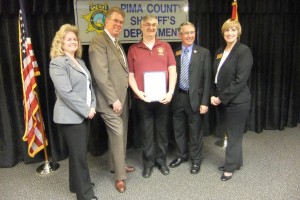
Arizona APCO-NENA Chapter President Sandra Gilstad, APCO 1st Vice President Gregg Riddle, Dispatch Supervisor Tony Portrey, NENA President Steve O'Conor and NENA 2nd Vice President Barbara Jaeger
“Thank you for all the sacrifices you make to create a better and safer world for the public,” said Riddle. “Your commitment to your profession is appreciated by all of APCO International, the public safety communications community, and especially the citizens you serve.
“The individuals recognized today are representative of the thousands of dedicated men and women who work everyday, around the clock, to answer the call when the public needs help,” Riddle continued. “Although APCO International does all it can to honor our calltakers, dispatchers, supervisors, managers and technicians throughout the year, National Public Safety Telecommunications Week [April 10–16] has been set aside so everyone can be made more aware of your hard work and dedication, which provide a vital link to the public safety services that we have come to rely on every day.
“We encourage all of you this week to celebrate and honor yourselves, your co-workers, your bosses and your employees.”
About the Author
Keri Losavio is the editor of Public Safety Communications, the official magazine of APCO International. Contact her via e-mail.
View television coverage of the event: http://www.kvoa.com/videos/?id=5299
Lest They Be Forgotten
The dead:
• U.S. District Judge John Roll (63)
• Dorothy “Dot” Dorothy Morris (76), homemaker and secretary, whose husband, George, was also injured
• Dorwin Stoddard (76)—saved the life of his wife, Mavanell, who was shot in the leg three times
• Christina Greene (9)
• Phyllis Schneck (79), homemaker
• Gabriel “Gabe” Zimmerman (30), director of community outreach for Rep. Gabrielle Giffords
The wounded:
• Gabrielle Giffords (40)
• Pamela Simon (63)
• Mavanell Stoddard (75)
• George Morris (76)
• Randy Gardner (60)
• James Eric Fuller (63)
• Bill Badger (74)
• Ronald Barber (65)
• Susan Hileman (58)
• Mary Reed (52)
• Kenneth Dorushka (63)
• Kenneth Veeder (75)
• James Tucker (58)
Sources
• Pima County Sheriff’s Department
• 9-1-1 call transcript: http://www.kgun9.com/Global/story.asp?S=13811789
• http://www.msnbc.msn.com/id/40981099/ns/us_news-crime_and_courts/
• http://voices.washingtonpost.com/blog-post/2011/01/arizona_shooting_victims_the_i.html

